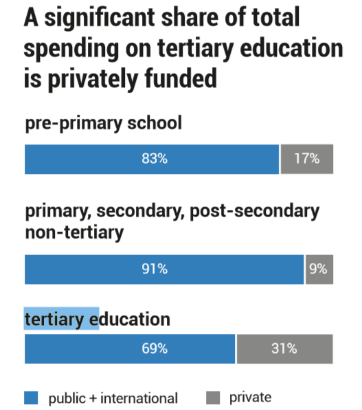Education at a glance: privatisation and commercialisation contribute to inequalities and educational gaps
Published:
This year’s OECD Education at a glance report, published 11th September 2018, focuses on equity, highlighting the significant impact of students’ socio-economic and immigrant background, as well as students’ gender, on their education and employment prospects. The report covers all 35 OECD countries, as well as other partner countries including Brazil, the Russian Federation, Argentina, China, Colombia, Costa Rica, India, Indonesia, and Lithuania.
The OECD remarks that significantly fewer children from low socio-economic backgrounds attend pre-primary school, and are likely to complete upper secondary school. Another factor contributing to dropping out of education, according to the report, is immigrant background: the likelihood of becoming a NEET (not in education, employment or training) increases by 5% if one is foreign-born and aged between 15-29 years old. OECD data also shows that men are less likely than women to complete secondary school or attain tertiary education. However, in the labour market, tertiary-educated women earn 26% less than their male counterparts.
 The report demonstrates that these gaps in education and the labour market are significantly widened by privatisation and the lack of public investment in education. This report displays that pre-primary and tertiary education are especially affected: while 91% of primary and secondary schools in OECD and partner countries are publicly-funded institutions, the share of private funding in the pre-primary and tertiary sector is 17% and 31% respectively. As regards public investment, the Czech Republic, Greece, Hungary, Ireland, Italy, Lithuania, Luxembourg and the Russian Federation invest on average only 3-4% of their GDP in the education sector. ETUCE warns of the increasing “internal privatisation” which is creeping into European schools, in the form of performance-based pay relying on test scores and annual performance reviews.
The report demonstrates that these gaps in education and the labour market are significantly widened by privatisation and the lack of public investment in education. This report displays that pre-primary and tertiary education are especially affected: while 91% of primary and secondary schools in OECD and partner countries are publicly-funded institutions, the share of private funding in the pre-primary and tertiary sector is 17% and 31% respectively. As regards public investment, the Czech Republic, Greece, Hungary, Ireland, Italy, Lithuania, Luxembourg and the Russian Federation invest on average only 3-4% of their GDP in the education sector. ETUCE warns of the increasing “internal privatisation” which is creeping into European schools, in the form of performance-based pay relying on test scores and annual performance reviews.
Insufficient public investment in education and increasing privatisation also make the teaching profession a low-paid and unattractive profession. According to this report, primary and secondary male teachers earn between 77%-88% of the income of other tertiary-educated men. This represents a vicious circle. As pre-primary and primary education are both associated with care-giving, they tend to be female-dominated sectors which are usually less-paid than employment in other education sectors. Men, however, are more often employed in better-paid, higher-status positions (e.g. in tertiary education), as well as in leadership positions. ETUCE notes that teachers’ salaries are not high enough to attract men into the profession, which is one of the direct consequences of women’s work being undervalued. Nonetheless, the report shows that the gender gap has narrowed at the tertiary level. Eurostat Education statistics show that only 21% of female employees in the higher education are employed as full professors. ETUCE stresses that gender equality in education and in society at large will not be realised unless gender segregation within the teaching profession is addressed and emphasises the critical role that education trade unions can play in this process.